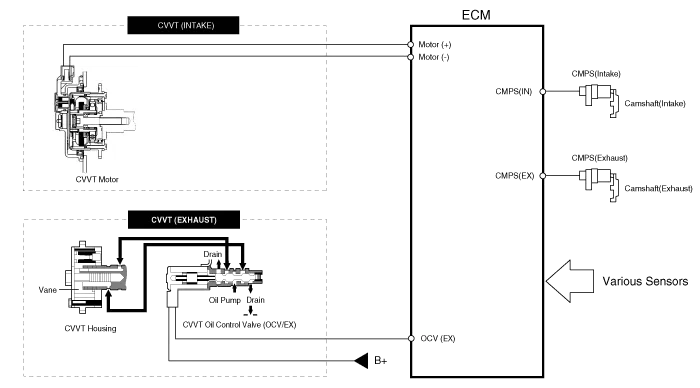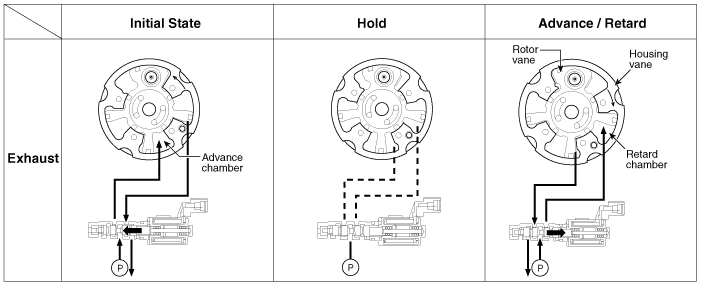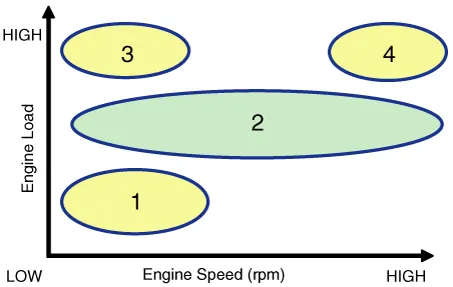Kia Stinger CK: Exhaust Emission Control System / CVVT (Continuous Variable Valve Timing) System
Description and operation
| Description |
Continuous Variable Valve Timing (CVVT) system advances or retards the valve timing of the intake and exhaust valve in accordance with the ECM control signal which is calculated by the engine speed and load. By controlling CVVT, the valve over-lap or under-lap occurs, which makes better fuel economy and reduces exhaust gases (NOx, HC) and improves engine performance through reduction of pumping loss, internal EGR effect, improvement of combustion stability, improvement of volumetric efficiency, and increase of expansion work.
| [Intake] |
Electric E-CVVT system is electric continuous variable valve timing system. It is located on the intake camshaft of the engine and uses motor rotation to control the rotation angle of camshaft relative to the rotation of crankshaft regardless of engine pressure. E-CVVT controls the DC motor current (duty signal) to more closely control the system compared to the previous pressure type, by increasing reaction speed of cam, improving startability, and reducing the emission of exhaust gas. Also, operation range of intake valve (valve opening angle) is expanded. So, the output and fuel efficiency are improved.
| [Exhaust] |
This system consists of the CVVT Oil Control Valve (OCV) which supplies the engine oil to the cam phaser or runs out the engine oil from the cam phaser in accordance with the ECM PWM (Pulse With Modulation) control signal which measures the engine oil temperature, and the Cam Phaser which varies the cam phase by using the hydraulic force of the engine oil. The engine oil released from the CVVT oil control valve varies the cam phase in the direction (Intake Advance/Exhaust Retard) or opposite direction (Intake Retard/Exhaust Advance) of the engine rotation by rotating the rotor connected with the camshaft inside the cam phaser.

| Operation Principle |
| [Intake] |

| [Exhaust] |
The CVVT has the mechanism of rotating the rotor vane with hydraulic force generated by the engine oil supplied to the advance or retard chamber in accordance with the CVVT oil control valve control.

| [CVVT System Mode] |

|
(1) Low Speed / Low Load |
(2) Partial Load |
|
|
|
|
(3) Low Speed / High Load |
(4) High Speed / High Load |
|
|
|
|
Driving Condition |
Exhaust Valve |
Intake Valve |
||
|
Valve Timing |
Effect |
Valve Timing |
Effect |
|
|
(1) Low Speed/Low Load |
Completely Advance |
* Valve Under-lap |
Completely Retard |
* Valve Under-lap |
|
* Improvement of combustion stability |
* Improvement of combustion stability |
|||
|
(2) Partial Load |
Retard |
* Increase of expansion work |
Retard |
* Reduction of pumping loss |
|
* Reduction of pumping loss |
||||
|
* Reduction of HC |
||||
|
(3) Low Speed/High Load |
Retard |
* Increase of expansion work |
Advance |
* Prevention of intake back flow (Improvement of volumetric efficiency)
|
|
(4) High Speed/High Load |
Advance |
* Reduction of pumping loss |
Retard |
* Improvement of volumetric efficiency |
Other information:
Kia Stinger (CK) 2018-2023 Service Manual: Using All Wheel Drive (AWD)
The All Wheel Drive (AWD) System delivers engine power to front and rear wheels for maximum traction. AWD is useful when extra traction is required, such as when driving slippery, muddy, wet, or snow-covered roads. If the system determines there is a need for four wheel drive, the engine's driving power is distributed to all four wheels automatically.Kia Stinger (CK) 2018-2023 Service Manual: FCA front radar / camera sensor
In order for the FCA system to operate properly, always make sure the sensor or sensor cover is clean and free of dirt, snow, and debris. Dirt, snow, or foreign substances on the lens may adversely affect the sensing performance of the sensor. ✽ NOTICE Do not install any accessories, such as a license plate bracket or bumper sticker near the sensor area.Categories
- Manuals Home
- Kia Stinger Owners Manual
- Kia Stinger Service Manual
- New on site
- Most important about car






